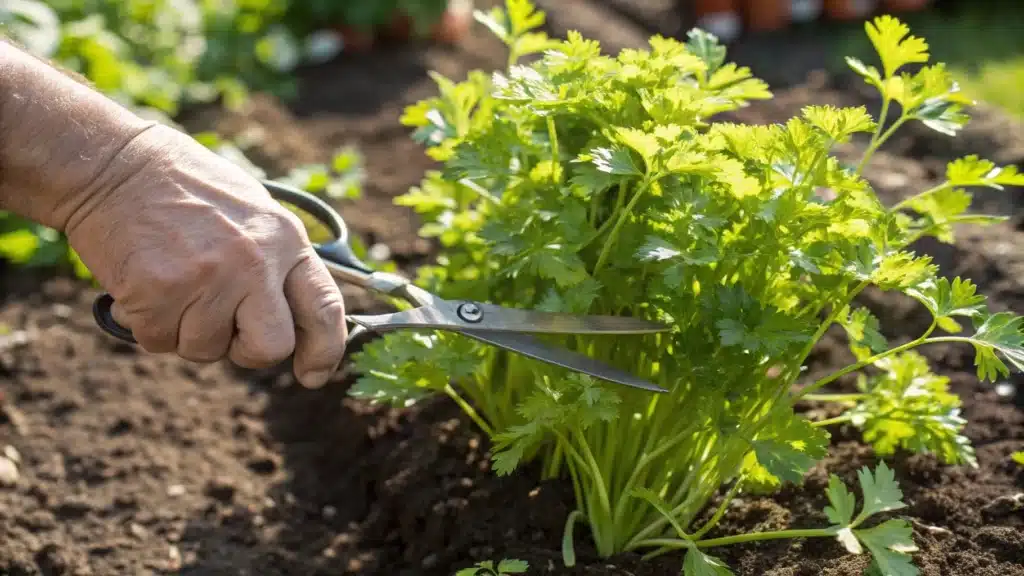Italian parsley, with its vibrant green leaves and fresh taste, is more than just a kitchen staple. It’s a versatile herb that can transform your garden and your meals. Whether you’re using it in a salad, a sauce, or as a garnish, Italian parsley adds a burst of flavor and a touch of elegance to any dish. Plus, it’s packed with nutrients and easy to grow, making it a must-have for both seasoned chefs and home gardeners.
Table of Contents
The Versatility of Italian Parsley in Cooking
Enhancing Flavors with Italian Parsley

Italian parsley is more than just a decorative garnish; it’s a flavor powerhouse. This herb can transform a dish with its fresh, slightly peppery taste. Adding Italian parsley to your meals can be like adding a splash of brightness, complementing the flavors of rich, savory ingredients. It pairs beautifully with meats, soups, and stews, enhancing their flavors without overpowering them.
Italian Parsley in Global Cuisines
Parsley isn’t confined to Italian kitchens. It’s a global traveler, finding its place in cuisines around the world. In Middle Eastern dishes, it’s a key ingredient in tabbouleh, offering a refreshing balance to the tangy flavors. In Latin American cuisine, parsley is often used in chimichurri, a vibrant sauce that accompanies grilled meats. Its versatility makes it a universal herb, capable of bridging diverse culinary traditions.
From Garnish to Main Ingredient
Gone are the days when parsley was just a sprinkle on the side. Today, it takes center stage in many recipes. Consider a parsley pesto, where this herb is the star, or a parsley salad, where its fresh leaves are the main attraction. As a main ingredient, parsley brings a unique flavor and a burst of green to your plate, proving that it’s much more than a simple garnish.
Nutritional Powerhouse: Health Benefits
Vitamins and Minerals
Italian parsley is packed with essential nutrients that can boost your health in various ways. Rich in vitamins A, C, and K, this herb is a great addition to your diet if you’re looking to support your immune system and maintain healthy skin and bones. Parsley also contains a good amount of calcium, iron, and potassium, making it a well-rounded choice for anyone focusing on nutrition. Here’s a quick look at the key nutrients:
| Nutrient | Benefits |
|---|---|
| Vitamin A | Supports vision and immune function |
| Vitamin C | Boosts immunity and skin health |
| Vitamin K | Essential for bone health |
| Calcium | Strengthens bones |
| Iron | Supports blood health |
| Potassium | Regulates fluid balance |
Boosting Immunity
Including Italian parsley in your meals can give your immune system a significant boost. The high vitamin C content helps combat colds and other infections, while its antioxidants fight off free radicals. For those looking to enhance their body’s natural defenses, this herb is a simple yet effective addition.
Supporting Bone Health and Skin
Italian parsley isn’t just about flavor; it’s also about maintaining your body’s structure. The combination of calcium and vitamin K found in parsley plays a vital role in keeping your bones strong. Meanwhile, the vitamin C content aids in collagen production, which is crucial for healthy skin. By adding parsley to your diet, you’re not just seasoning your food — you’re supporting your body’s fundamental needs.
Italian parsley is more than just a garnish; it’s a stealthy nutritional powerhouse that can transform your meals and health. Whether you’re sprinkling it over a dish or blending it into a smoothie, each leaf is packed with benefits that your body will thank you for.
Growing Italian Parsley: A Gardener’s Guide
Indoor vs. Outdoor Cultivation

Growing Italian flat leaf parsley is a rewarding endeavor whether you choose to cultivate it indoors or outdoors. Indoor cultivation offers the advantage of year-round harvest, provided you have a sunny window or grow lights. Ensure your pots have good drainage and use a high-quality potting mix. Outdoors, flat leaf parsley thrives in well-drained soil enriched with organic matter. Plant seeds or transplants after the last frost, spacing them about 6-12 inches apart.
Companion Planting with Italian Parsley
Parsley is a green herb that plays well with others in the garden. It benefits from being planted alongside vegetables like tomatoes, carrots, and asparagus. These companions not only share similar growing conditions but also help deter pests. Additionally, parsley attracts beneficial insects such as ladybugs and hoverflies, which can help keep harmful pests at bay.
Troubleshooting Common Issues
Despite its resilience, the parsley plant can face challenges. Yellowing leaves might signal overwatering or poor soil drainage. Ensure your soil is well-draining and adjust watering accordingly. Pests like aphids and caterpillars can also pose problems. Handpicking or using insecticidal soap can effectively manage these pests. Keep an eye out for the flat leaved parsley flower, which indicates the plant is bolting and may soon lose flavor.
Keeping the soil moist is crucial for parsley, but overwatering can be a common pitfall. Using mulch helps retain moisture and reduces the need for frequent watering. Drip irrigation systems are another efficient way to conserve water, delivering it directly to the plant roots where it’s most needed. According to the University of Rhode Island, drip irrigation minimizes evaporation and improves water efficiency, making it a sustainable choice for home gardeners.
Growing Italian parsley is not without its quirks, but the vibrant green leaves it produces are worth the effort. Whether you choose curly leaf or flat leaf varieties, with the right care, your parsley will flourish and add a fresh touch to your culinary creations.
Harvesting and Storing

Best Practices for Harvesting
When it comes to harvesting Italian parsley, timing is key. Pick the leaves in the morning when the essential oils are most concentrated. This ensures maximum flavor and aroma. Use a sharp knife or scissors to cut the stems, starting with the outer leaves and working your way in. Regular harvesting encourages the plant to produce more foliage, so don’t hesitate to snip what you need.
Storing Fresh Italian Parsley
To keep your Italian parsley fresh, trim the stems and place them in a jar with water, much like a bouquet. Cover it loosely with a plastic bag and store it in the refrigerator. This method can keep your parsley vibrant for up to two weeks. Alternatively, if you’re short on space, consider using a larger container to house multiple bunches.
Freezing and Preserving Techniques
For longer-term storage, freezing parsley is a great option. Wash and dry the leaves thoroughly, then chop them finely. You can freeze them in airtight bags or use ice cube trays filled with water or olive oil to create handy parsley cubes. These cubes are perfect for adding a burst of flavor to soups and stews.
Italian parsley, or petroselinum crispum var, is more than just a garnish. With the right care in harvesting and storing, this herb can be a year-round staple in your kitchen, offering a fresh taste of the garden even in the depths of winter.
Italian Parsley Varieties: Choosing the Right Type for Your Garden
Flat-Leaf vs. Curly Parsley
When you’re thinking about adding parsley to your garden, you’ve got two main contenders: flat-leaf and curly parsley. Flat-leaf parsley, also known as Italian parsley, is favored for its robust flavor and ease of chopping. It’s the go-to for chefs who want a punch of taste in their dishes. On the other hand, curly parsley, with its milder flavor, makes for a pretty garnish. Its ruffled leaves add a decorative touch, so if aesthetics are your thing, curly might be your choice.
Selecting Seeds and Transplants
Starting parsley from seeds can test your patience. Germination is slow and can be erratic, taking up to six weeks. For a head start, soak seeds overnight before planting. If you’re not into waiting, picking up a transplant from a nursery can speed things up. When choosing seeds or transplants, look for healthy, vibrant green leaves and avoid any signs of wilting or yellowing.
Understanding Growth Habits
Parsley is a biennial, meaning it has a two-year life cycle. In the first year, it focuses on growing lush leaves, while in the second year, it flowers and sets seed. It’s essential to note that flat-leaf varieties tend to be hardier and may withstand winter better than their curly counterparts. Plant them about 9 inches apart in a spot with plenty of sunlight. Whether you decide on flat-leaf or curly, both types will bring their unique qualities to your garden, enhancing both flavor and visual appeal.
Creative Culinary Uses for Italian Parsley
Italian Parsley in Sauces and Dressings
Italian parsley isn’t just a pretty garnish; it’s a powerhouse in the kitchen. Its leaves bring a vibrant flavor to sauces and dressings that can elevate any dish. Whether you’re making a classic chimichurri or a zesty vinaigrette, the fresh parsley leaf adds a peppery punch that’s hard to beat. Try blending it with garlic, lemon juice, and olive oil for a simple yet flavorful dressing that complements grilled meats and roasted vegetables.
Incorporating Italian Parsley in Salads
Gone are the days when parsley was merely a decorative touch. Incorporating Italian flat leaf parsley into salads brings a refreshing taste and a burst of color. Mix it with tomatoes, cucumbers, and feta for a Mediterranean twist, or toss it with grains like quinoa for a hearty, nutritious meal. The leaves flavor blends well with various ingredients, making it a versatile choice for any salad.
Italian Parsley as a Flavor Enhancer
Parsley is a stunning parsley that enhances the flavor of many dishes, from soups to stews. Add it at the end of cooking to preserve its bright taste. In broths, it provides a subtle earthiness, while in pasta dishes, it adds a fresh contrast to rich sauces. Don’t overlook curly parsley either; its milder taste is perfect for those who prefer a less intense flavor. Keep a bunch of fresh parsley handy to sprinkle on your meals, transforming ordinary dishes into extraordinary culinary experiences.
Embrace the versatility of Italian parsley in your kitchen. Its ability to enhance flavors and add a touch of freshness makes it an indispensable herb for any home cook. Whether you’re using it in sauces, salads, or as a finishing touch, this herb is sure to bring life to your culinary creations.
Sustainable Gardening Practices for Italian Parsley

Organic Growing Methods
To grow Italian parsley sustainably, start with organic soil. This not only provides essential nutrients but also ensures a healthy growing environment. When planting, use a container with drainage hole to prevent waterlogging, which can harm the plant. Organic fertilizers, like compost or worm castings, can be added to enrich the soil further, promoting robust growth.
Water Conservation Techniques
Keeping the soil moist is crucial for parsley, but overwatering can be a common pitfall. Using mulch helps retain moisture and reduces the need for frequent watering. Drip irrigation systems are another efficient way to conserve water, delivering it directly to the plant roots where it’s most needed. According to the University of Rhode Island, drip irrigation minimizes evaporation and improves water efficiency, making it a sustainable choice for home gardeners.
Promoting Biodiversity in Your Garden
Italian parsley can be a great companion plant. Its presence can attract beneficial insects like ladybugs and hoverflies, which help control pests naturally. Consider planting it alongside tomatoes or roses for added benefits, as it can enhance their growth and deter pests. By integrating parsley into a diverse garden setup, you create a balanced ecosystem that supports various plant and insect life.
Growing Italian parsley sustainably not only benefits your garden but also contributes to a healthier planet. By using organic methods and conserving resources, you’re making a positive environmental impact while enjoying fresh, flavorful herbs.
The Historical Significance of Italian Parsley
Origins and Cultural Importance
Italian parsley, also known as flat-leaf parsley, traces its roots back to the Mediterranean region, thriving in the mild climate of areas like Sardinia. This herb has been cherished for centuries, not just for its culinary uses but also for its symbolic meanings. In ancient Greek culture, parsley was intertwined with mythology and death, often used to adorn tombs. Its presence was a symbol of rebirth and renewal, reflecting its vibrant green color and hardy nature.
Italian Parsley in Ancient Cuisines
In ancient times, parsley was more than just a flavor enhancer; it was a staple in diets across various civilizations. The Greeks and Romans incorporated parsley into their dishes not only for taste but also for its believed medicinal properties. It was common in Roman feasts, where it was thought to aid digestion and freshen breath. Parsley was also used in a variety of sauces and salads, highlighting its versatility long before modern culinary practices.
Evolution of Italian Parsley in Modern Cooking
Fast forward to today, and Italian parsley has evolved from its ancient origins to become a kitchen essential worldwide. Its journey from a symbolic plant to a culinary staple showcases its adaptability and enduring appeal. In contemporary cooking, parsley is celebrated for its ability to brighten flavors and add a fresh, peppery note to dishes. Whether used as a garnish or a main ingredient, its role in modern cuisine is both significant and diverse, reflecting a rich history that continues to influence our palates.
Continue your herb exploration with our tips on gardening oregano and Red Creeping Thyme. These plants bring unforgettable flavors and health benefits!
Conclusion
In wrapping up our exploration of Italian parsley, it’s clear that this vibrant herb is more than just a garnish. Whether you’re a seasoned chef or a home cook, adding parsley to your garden can be a game-changer. Its ability to enhance flavors, coupled with its nutritional benefits, makes it a must-have in any kitchen. Plus, growing parsley is a breeze, whether you choose to plant it indoors or out. So, why not give it a try? With a little care, you’ll have a fresh supply of this versatile herb at your fingertips, ready to elevate your dishes to new heights.
Frequently Asked Questions
What is the best way to use Italian parsley in cooking?
Italian parsley can be used as a garnish, in salads, or as a main ingredient in sauces and dressings. It adds a fresh, peppery flavor to dishes.
What are the health benefits of eating Italian parsley?
Italian parsley is rich in vitamins A, C, and K, which help boost immunity, support bone health, and promote healthy skin.
How do I grow Italian parsley at home?
You can grow Italian parsley indoors in pots with good drainage or outdoors in a sunny spot. Make sure to water it regularly.
What is the difference between flat-leaf and curly parsley?
Flat-leaf parsley, also known as Italian parsley, has a stronger flavor, while curly parsley is milder and often used as a garnish.
How do I store fresh Italian parsley?
To keep parsley fresh, trim the stems and place it in a jar with water. Cover it loosely with a plastic bag and store it in the fridge.
Can I freeze Italian parsley?
Yes, you can freeze Italian parsley. Chop it and freeze in ice cube trays with water or olive oil for easy use in recipes.


3 thoughts on “Italian Parsley: Transform Your Garden with This Vibrant Herb”